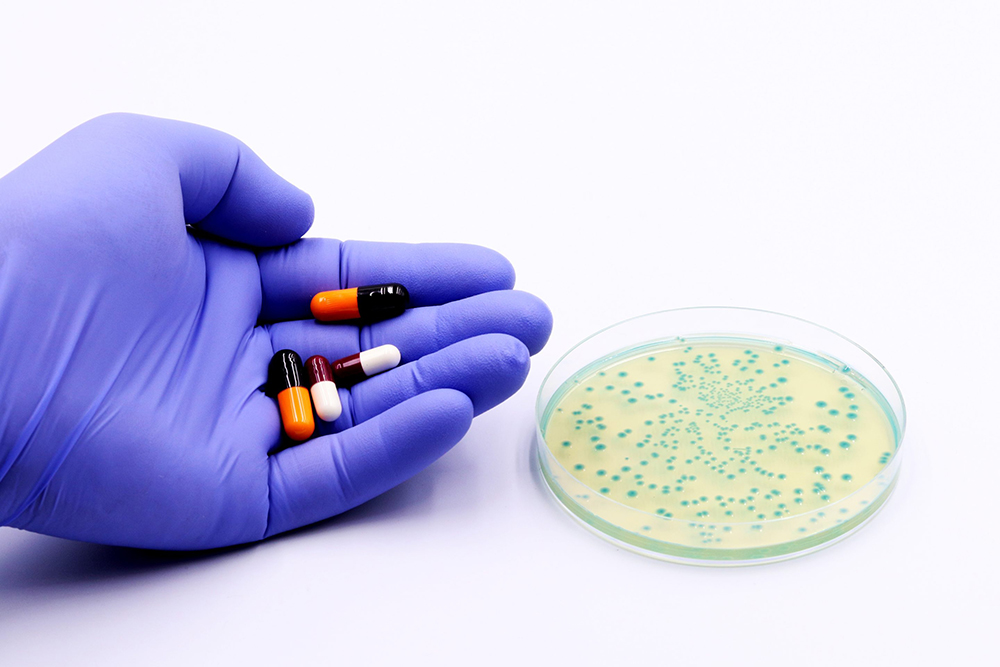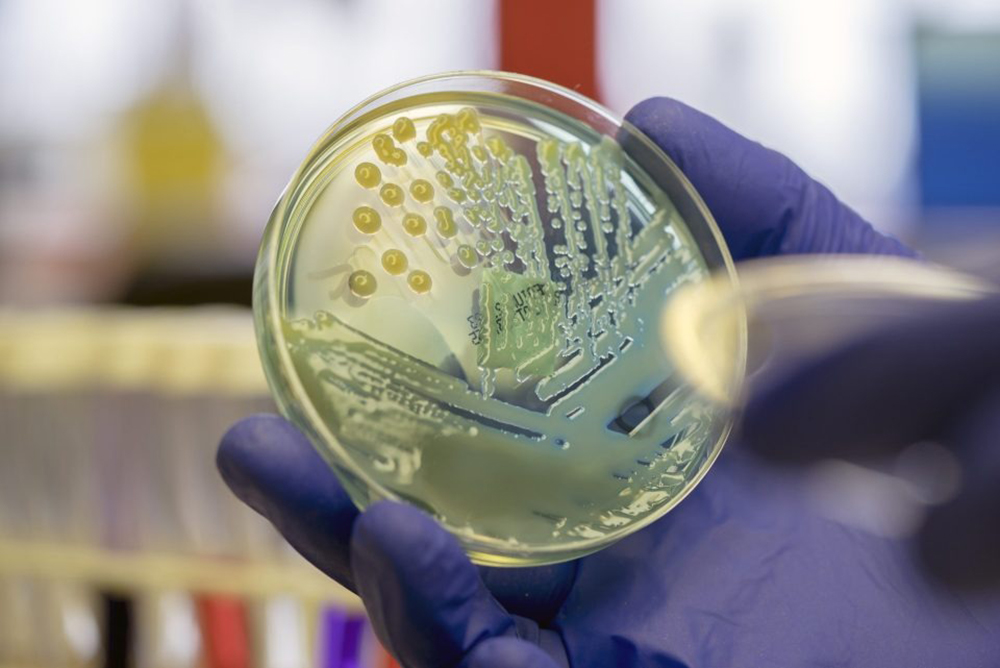
一個(gè)全球公共衛(wèi)生危機(jī)剛剛退場(chǎng),另一個(gè)就已經(jīng)悄然站在了舞臺(tái)中央,。新冠病毒感染剛摘下“公共衛(wèi)生緊急事件”的帽子不到一年,,一群國(guó)際政治、公共衛(wèi)生和生物醫(yī)學(xué)專(zhuān)家又警告我們說(shuō),,人類(lèi)的生命正面臨著新的威脅,,而且它還有可能給我們?cè)斐删揞~的經(jīng)濟(jì)損失。
這個(gè)問(wèn)題就是對(duì)抗生素的耐藥性問(wèn)題,,也就是說(shuō)某些細(xì)菌會(huì)對(duì)抗生素產(chǎn)生抗體,。據(jù)抗生素耐藥性問(wèn)題全球領(lǐng)導(dǎo)小組(GLG)發(fā)表的一份最新報(bào)告稱(chēng),到 2035 年,,抗生素耐藥性問(wèn)題將使全球人口預(yù)期壽命平均縮短1.8歲,,而一些中低收入國(guó)家的人口預(yù)期壽命甚至可能會(huì)縮短2.5歲。
該報(bào)告指出,,抗生素耐藥性問(wèn)題還將對(duì)“全球經(jīng)濟(jì)產(chǎn)生災(zāi)難性影響”,。預(yù)計(jì)到 2035年,,抗生素耐藥性問(wèn)題每年造成的經(jīng)濟(jì)損失總額將達(dá)到8550億美元,。其中大約4120億美元是直接醫(yī)療成本,另外4430億美元?jiǎng)t是由于發(fā)病率和死亡率上升而造成的生產(chǎn)力損失和勞動(dòng)參與率下降的成本,。
該報(bào)告是在本月早些時(shí)候發(fā)布的,。該全球領(lǐng)導(dǎo)小組呼吁各聯(lián)合國(guó)會(huì)員國(guó)采取積極舉措,緩解抗生素耐藥性問(wèn)題帶來(lái)的全球性健康風(fēng)險(xiǎn),。根據(jù)該小組隨后發(fā)布的新聞稿,,這些舉措包括劃撥足夠的資金“用于解決新型抗生素研發(fā)渠道日益減少的問(wèn)題”。而在聯(lián)合國(guó)關(guān)于抗生素耐藥性的第一次高級(jí)別會(huì)議召開(kāi)8年后,,第二次相關(guān)會(huì)議也將于今年9月的聯(lián)大期間召開(kāi),。
巴巴多斯總理兼抗生素耐藥性問(wèn)題全球領(lǐng)導(dǎo)小組組長(zhǎng)米婭·阿莫爾·莫特利在新聞發(fā)布會(huì)上表示:“我們是有緩解抗生素耐藥性危機(jī)的工具的。而些這些數(shù)據(jù)表明,,如果我們不立即采取大膽的行動(dòng),,未來(lái)將是災(zāi)難性的。因此,,全球領(lǐng)導(dǎo)小組做出了這些建議,,敦促全球采取有力措施應(yīng)對(duì)抗生素耐藥性問(wèn)題,以拯救數(shù)百萬(wàn)人的生命,?!?/p>
為什么說(shuō)抗生素耐藥性問(wèn)題是全球性的公共衛(wèi)生威脅?
真菌,、寄生蟲(chóng),、病毒和細(xì)菌等病原體都可導(dǎo)致動(dòng)植物和人類(lèi)被感染。而它們也有可能進(jìn)化到不再懼怕抗生素類(lèi)藥物(也包括抗生素、抗真菌藥,、抗寄生蟲(chóng)藥和抗病毒藥)的地步,。世衛(wèi)組織也發(fā)明出了“超級(jí)耐藥菌”一詞,用于代指這類(lèi)進(jìn)化出了抗生素耐藥性的病原體,。
密歇根州立大學(xué)藥理與毒理學(xué)副教授杰米·艾倫博士告訴《財(cái)富》:“一旦人們過(guò)量使用抗生素,,情況就會(huì)變得更糟。很多時(shí)候,,人們根本不需要使用抗生素,。”
比方說(shuō),,如果你的耳朵發(fā)炎了,,它有可能是細(xì)菌性的,也可能是病互不性的,。你可能會(huì)覺(jué)得很難受,,所以你決定去看醫(yī)生,希望醫(yī)生能給你開(kāi)點(diǎn)抗生素,。但是如果你是細(xì)菌感染的話,,那么等你難受到需要去看醫(yī)生的時(shí)候,你實(shí)際上可能已經(jīng)離康復(fù)不遠(yuǎn)了,,因?yàn)楹芏喔腥颈旧砭褪强梢宰杂?。如果你是病毒感染,那么抗生素不僅不對(duì)癥,,反而有可能刺激你的病原體發(fā)生變異,。而你也就有了將變異后的病原體傳染給別人的風(fēng)險(xiǎn)。
艾倫表示:“久而久之,,這就會(huì)催生出一些對(duì)很多抗生素產(chǎn)生了耐藥性的‘超級(jí)耐藥菌’,。一旦人們感染了這些病原體,他們的死亡幾率就會(huì)更高,。原因很簡(jiǎn)單,,因?yàn)楝F(xiàn)在我們的很多抗生素都不起作用了?!?/p>
根據(jù)發(fā)表在醫(yī)學(xué)期刊《柳葉刀》上的一項(xiàng)分析,,僅在2019年,抗生素耐藥性問(wèn)題就導(dǎo)致了全球495萬(wàn)人死亡,,其中直接死于抗生素耐藥性的有127萬(wàn)人,。世衛(wèi)組織已經(jīng)將抗生素耐藥性列為全球公共衛(wèi)生和發(fā)展面臨的首要威脅??股啬退幮詥?wèn)題全球領(lǐng)導(dǎo)小組提議,,全球應(yīng)在2030年前,想辦法將抗生素耐藥性造成的死亡率降低10%。
范德堡大學(xué)醫(yī)學(xué)中心傳染病部教授威廉·沙夫納博士認(rèn)為,,雖然抗生素耐藥性問(wèn)題在全球的影響規(guī)模不好準(zhǔn)確衡量,,但是我們必須要把它當(dāng)作一個(gè)世界性的難題來(lái)對(duì)待。
“我們生活在一個(gè)地球村里,,村子那邊的東西很快也會(huì)傳播到村子這邊,。”沙夫納對(duì)《財(cái)富》表示:“如果有人在美國(guó)生病了,,而且他們是從國(guó)外來(lái)的,,他們身上有這種耐藥菌,那么我們也只能在這里治療他們,。這對(duì)我們?cè)趪?guó)外的公民也是一樣的,。”
他還表示:“這既是一個(gè)地方性的問(wèn)題,,但同時(shí)我們也要把它看作是一個(gè)全球性的問(wèn)題,。”

制藥公司需要激勵(lì)來(lái)研發(fā)新抗生素
沙夫納指出,,對(duì)抗生素實(shí)行嚴(yán)格管理,,減少抗生素的處方量,,是遏制抗生素耐藥性問(wèn)題的第一步?!拔覀兪褂玫目股卦缴?,細(xì)菌就越不容易對(duì)現(xiàn)有抗生素產(chǎn)生耐藥性?!?/p>
艾倫強(qiáng)調(diào)道,,兒科往往也是抗生素濫用的重災(zāi)區(qū)。作為一名兒童家長(zhǎng),,她也理解孩子生病時(shí),,家長(zhǎng)心急如焚求醫(yī)問(wèn)藥的心情。但是抗生素并不適合每一種疾病,。
沙夫納還表示,,制藥行業(yè)在解決抗生素耐藥性問(wèn)題上也起著至關(guān)重要的作用。現(xiàn)在開(kāi)發(fā)新的抗生素要比以前更復(fù)雜,,成本也更高昂,。另外,一個(gè)人可能一年到底也吃不了幾片抗生素,可是如果你有高血壓的話,,你就得長(zhǎng)年累月地服用降壓藥,。因此,研發(fā)抗生素對(duì)于制藥公司來(lái)說(shuō),,是一筆高投入低回報(bào)的買(mǎi)賣(mài),。
另外,新研發(fā)出來(lái)的抗生素可能還會(huì)被“留著當(dāng)撒手锏”,,從而更難掙回研發(fā)成本,。沙夫納表示:“我想不出還有哪種商品上市后會(huì)遇見(jiàn)這種情況——一款新的抗生素藥物問(wèn)世了,但是傳染病界的反應(yīng)卻是:‘先別用它,,咱們省著用,,等別的抗生素沒(méi)效果了再上它?!?/p>
醫(yī)生們之所以會(huì)有這種反應(yīng),,是因?yàn)榫退忝魈炀陀幸豢钚碌目股厣鲜校蠹乙驳弥?jǐn)慎使用,,這樣才能保證未來(lái)幾年,,我們面對(duì)耐藥菌時(shí)還能有一記“撒手锏”。因此,,抗生素耐藥性問(wèn)題全球領(lǐng)導(dǎo)小組的這份報(bào)告強(qiáng)調(diào),,各國(guó)應(yīng)利用公共和私人投資對(duì)制藥企業(yè)提供激勵(lì),以促進(jìn)新藥研發(fā),。
美國(guó)國(guó)會(huì)2023年提交了一項(xiàng)《啟動(dòng)抗生素訂購(gòu)以終止耐藥性激增法案》(簡(jiǎn)稱(chēng)《PASTEUR》法案),,該法案呼吁美國(guó)成立“急需抗生素藥品委員會(huì)”,并計(jì)劃撥款60億美元用于遏制抗生素耐藥性問(wèn)題,,并與藥品開(kāi)發(fā)者簽訂合同,。雖然該法案已經(jīng)獲得了兩黨的支持,但它目前仍然卡在參議院,。
抗生素耐藥性問(wèn)題全球領(lǐng)導(dǎo)小組的另一個(gè)目標(biāo),,是到2030年前,將農(nóng)業(yè)生產(chǎn)中使用的抗生素用量減少30%到50%,。要實(shí)現(xiàn)這個(gè)目標(biāo),,全球范圍內(nèi)的干預(yù)措施成本預(yù)計(jì)將達(dá)到每年460億美元。不過(guò)到2050年前,,全球在這方面每投入1美元,,就有望獲得13美元的回報(bào)。
沙夫納表示,,在采取更具體的行動(dòng)以前,,要想利用現(xiàn)有手段控制住抗生素耐藥性問(wèn)題,,就需各方面共同努力。
他表示:“要解決這個(gè)問(wèn)題,,公眾,、醫(yī)學(xué)界(包括獸醫(yī))和農(nóng)業(yè)界必須共同努力,以確保這些抗生素能夠真正發(fā)揮作用,,對(duì)癥地去治療那些生了病的人和動(dòng)物,。”(財(cái)富中文網(wǎng))
譯者:樸成奎
根據(jù)全球抗生素耐藥性領(lǐng)導(dǎo)小組的一份新報(bào)告,,到2035年,,抗生素耐藥性將使全球平均預(yù)期壽命縮短1.8歲。TOPMICROBIALSTOCK—GETTY IMAGES
一個(gè)全球公共衛(wèi)生危機(jī)剛剛退場(chǎng),,另一個(gè)就已經(jīng)悄然站在了舞臺(tái)中央,。新冠病毒感染剛摘下“公共衛(wèi)生緊急事件”的帽子不到一年,一群國(guó)際政治,、公共衛(wèi)生和生物醫(yī)學(xué)專(zhuān)家又警告我們說(shuō),,人類(lèi)的生命正面臨著新的威脅,而且它還有可能給我們?cè)斐删揞~的經(jīng)濟(jì)損失,。
這個(gè)問(wèn)題就是對(duì)抗生素的耐藥性問(wèn)題,,也就是說(shuō)某些細(xì)菌會(huì)對(duì)抗生素產(chǎn)生抗體。據(jù)抗生素耐藥性問(wèn)題全球領(lǐng)導(dǎo)小組(GLG)發(fā)表的一份最新報(bào)告稱(chēng),,到 2035 年,,抗生素耐藥性問(wèn)題將使全球人口預(yù)期壽命平均縮短1.8歲,而一些中低收入國(guó)家的人口預(yù)期壽命甚至可能會(huì)縮短2.5歲,。
該報(bào)告指出,,抗生素耐藥性問(wèn)題還將對(duì)“全球經(jīng)濟(jì)產(chǎn)生災(zāi)難性影響”。預(yù)計(jì)到 2035年,,抗生素耐藥性問(wèn)題每年造成的經(jīng)濟(jì)損失總額將達(dá)到8550億美元,。其中大約4120億美元是直接醫(yī)療成本,另外4430億美元?jiǎng)t是由于發(fā)病率和死亡率上升而造成的生產(chǎn)力損失和勞動(dòng)參與率下降的成本,。
該報(bào)告是在本月早些時(shí)候發(fā)布的。該全球領(lǐng)導(dǎo)小組呼吁各聯(lián)合國(guó)會(huì)員國(guó)采取積極舉措,,緩解抗生素耐藥性問(wèn)題帶來(lái)的全球性健康風(fēng)險(xiǎn),。根據(jù)該小組隨后發(fā)布的新聞稿,這些舉措包括劃撥足夠的資金“用于解決新型抗生素研發(fā)渠道日益減少的問(wèn)題”,。而在聯(lián)合國(guó)關(guān)于抗生素耐藥性的第一次高級(jí)別會(huì)議召開(kāi)8年后,,第二次相關(guān)會(huì)議也將于今年9月的聯(lián)大期間召開(kāi)。
巴巴多斯總理兼抗生素耐藥性問(wèn)題全球領(lǐng)導(dǎo)小組組長(zhǎng)米婭·阿莫爾·莫特利在新聞發(fā)布會(huì)上表示:“我們是有緩解抗生素耐藥性危機(jī)的工具的,。而些這些數(shù)據(jù)表明,,如果我們不立即采取大膽的行動(dòng),,未來(lái)將是災(zāi)難性的。因此,,全球領(lǐng)導(dǎo)小組做出了這些建議,,敦促全球采取有力措施應(yīng)對(duì)抗生素耐藥性問(wèn)題,以拯救數(shù)百萬(wàn)人的生命,?!?/p>
為什么說(shuō)抗生素耐藥性問(wèn)題是全球性的公共衛(wèi)生威脅?
真菌,、寄生蟲(chóng),、病毒和細(xì)菌等病原體都可導(dǎo)致動(dòng)植物和人類(lèi)被感染。而它們也有可能進(jìn)化到不再懼怕抗生素類(lèi)藥物(也包括抗生素,、抗真菌藥,、抗寄生蟲(chóng)藥和抗病毒藥)的地步。世衛(wèi)組織也發(fā)明出了“超級(jí)耐藥菌”一詞,,用于代指這類(lèi)進(jìn)化出了抗生素耐藥性的病原體,。
密歇根州立大學(xué)藥理與毒理學(xué)副教授杰米·艾倫博士告訴《財(cái)富》:“一旦人們過(guò)量使用抗生素,情況就會(huì)變得更糟,。很多時(shí)候,,人們根本不需要使用抗生素?!?/p>
比方說(shuō),,如果你的耳朵發(fā)炎了,它有可能是細(xì)菌性的,,也可能是病互不性的,。你可能會(huì)覺(jué)得很難受,所以你決定去看醫(yī)生,,希望醫(yī)生能給你開(kāi)點(diǎn)抗生素,。但是如果你是細(xì)菌感染的話,那么等你難受到需要去看醫(yī)生的時(shí)候,,你實(shí)際上可能已經(jīng)離康復(fù)不遠(yuǎn)了,,因?yàn)楹芏喔腥颈旧砭褪强梢宰杂摹H绻闶遣《靖腥?,那么抗生素不僅不對(duì)癥,,反而有可能刺激你的病原體發(fā)生變異。而你也就有了將變異后的病原體傳染給別人的風(fēng)險(xiǎn),。
艾倫表示:“久而久之,,這就會(huì)催生出一些對(duì)很多抗生素產(chǎn)生了耐藥性的‘超級(jí)耐藥菌’。一旦人們感染了這些病原體,,他們的死亡幾率就會(huì)更高,。原因很簡(jiǎn)單,,因?yàn)楝F(xiàn)在我們的很多抗生素都不起作用了?!?/p>
根據(jù)發(fā)表在醫(yī)學(xué)期刊《柳葉刀》上的一項(xiàng)分析,,僅在2019年,抗生素耐藥性問(wèn)題就導(dǎo)致了全球495萬(wàn)人死亡,,其中直接死于抗生素耐藥性的有127萬(wàn)人,。世衛(wèi)組織已經(jīng)將抗生素耐藥性列為全球公共衛(wèi)生和發(fā)展面臨的首要威脅??股啬退幮詥?wèn)題全球領(lǐng)導(dǎo)小組提議,,全球應(yīng)在2030年前,想辦法將抗生素耐藥性造成的死亡率降低10%,。
范德堡大學(xué)醫(yī)學(xué)中心傳染病部教授威廉·沙夫納博士認(rèn)為,,雖然抗生素耐藥性問(wèn)題在全球的影響規(guī)模不好準(zhǔn)確衡量,但是我們必須要把它當(dāng)作一個(gè)世界性的難題來(lái)對(duì)待,。
“我們生活在一個(gè)地球村里,,村子那邊的東西很快也會(huì)傳播到村子這邊?!鄙撤蚣{對(duì)《財(cái)富》表示:“如果有人在美國(guó)生病了,,而且他們是從國(guó)外來(lái)的,他們身上有這種耐藥菌,,那么我們也只能在這里治療他們,。這對(duì)我們?cè)趪?guó)外的公民也是一樣的?!?/p>
他還表示:“這既是一個(gè)地方性的問(wèn)題,,但同時(shí)我們也要把它看作是一個(gè)全球性的問(wèn)題?!?/p>
制藥公司需要激勵(lì)來(lái)研發(fā)新抗生素
沙夫納指出,,對(duì)抗生素實(shí)行嚴(yán)格管理,減少抗生素的處方量,,是遏制抗生素耐藥性問(wèn)題的第一步,。“我們使用的抗生素越少,,細(xì)菌就越不容易對(duì)現(xiàn)有抗生素產(chǎn)生耐藥性,。”
艾倫強(qiáng)調(diào)道,,兒科往往也是抗生素濫用的重災(zāi)區(qū)。作為一名兒童家長(zhǎng),,她也理解孩子生病時(shí),,家長(zhǎng)心急如焚求醫(yī)問(wèn)藥的心情,。但是抗生素并不適合每一種疾病。
沙夫納還表示,,制藥行業(yè)在解決抗生素耐藥性問(wèn)題上也起著至關(guān)重要的作用?,F(xiàn)在開(kāi)發(fā)新的抗生素要比以前更復(fù)雜,成本也更高昂,。另外,,一個(gè)人可能一年到底也吃不了幾片抗生素,可是如果你有高血壓的話,,你就得長(zhǎng)年累月地服用降壓藥,。因此,研發(fā)抗生素對(duì)于制藥公司來(lái)說(shuō),,是一筆高投入低回報(bào)的買(mǎi)賣(mài),。
另外,新研發(fā)出來(lái)的抗生素可能還會(huì)被“留著當(dāng)撒手锏”,,從而更難掙回研發(fā)成本,。沙夫納表示:“我想不出還有哪種商品上市后會(huì)遇見(jiàn)這種情況——一款新的抗生素藥物問(wèn)世了,但是傳染病界的反應(yīng)卻是:‘先別用它,,咱們省著用,,等別的抗生素沒(méi)效果了再上它?!?/p>
醫(yī)生們之所以會(huì)有這種反應(yīng),,是因?yàn)榫退忝魈炀陀幸豢钚碌目股厣鲜校蠹乙驳弥?jǐn)慎使用,,這樣才能保證未來(lái)幾年,,我們面對(duì)耐藥菌時(shí)還能有一記“撒手锏”。因此,,抗生素耐藥性問(wèn)題全球領(lǐng)導(dǎo)小組的這份報(bào)告強(qiáng)調(diào),,各國(guó)應(yīng)利用公共和私人投資對(duì)制藥企業(yè)提供激勵(lì),以促進(jìn)新藥研發(fā),。
美國(guó)國(guó)會(huì)2023年提交了一項(xiàng)《啟動(dòng)抗生素訂購(gòu)以終止耐藥性激增法案》(簡(jiǎn)稱(chēng)《PASTEUR》法案),,該法案呼吁美國(guó)成立“急需抗生素藥品委員會(huì)”,并計(jì)劃撥款60億美元用于遏制抗生素耐藥性問(wèn)題,,并與藥品開(kāi)發(fā)者簽訂合同,。雖然該法案已經(jīng)獲得了兩黨的支持,但它目前仍然卡在參議院,。
抗生素耐藥性問(wèn)題全球領(lǐng)導(dǎo)小組的另一個(gè)目標(biāo),,是到2030年前,將農(nóng)業(yè)生產(chǎn)中使用的抗生素用量減少30%到50%,。要實(shí)現(xiàn)這個(gè)目標(biāo),,全球范圍內(nèi)的干預(yù)措施成本預(yù)計(jì)將達(dá)到每年460億美元,。不過(guò)到2050年前,全球在這方面每投入1美元,,就有望獲得13美元的回報(bào),。
沙夫納表示,在采取更具體的行動(dòng)以前,,要想利用現(xiàn)有手段控制住抗生素耐藥性問(wèn)題,,就需各方面共同努力。
他表示:“要解決這個(gè)問(wèn)題,,公眾,、醫(yī)學(xué)界(包括獸醫(yī))和農(nóng)業(yè)界必須共同努力,以確保這些抗生素能夠真正發(fā)揮作用,,對(duì)癥地去治療那些生了病的人和動(dòng)物,。”(財(cái)富中文網(wǎng))
譯者:樸成奎
As one public health threat takes a bow, another takes center stage. Less than a year after the end of the federal COVID-19 Public Health Emergency, a group of international political, public health, and biomedical leaders warns of another menace to human life that could also trigger economic loss.
Antimicrobial resistance (AMR)—which occurs when certain germs survive the drugs engineered to eradicate them—is on track to lower global life expectancy by an average 1.8 years by 2035, according to a new report from the Global Leaders Group (GLG) on Antimicrobial Resistance. For some low- and middle-income countries, life expectancy could fall by as much as 2.5 years.
AMR is also poised to have “a catastrophic effect on the global economy,” the report says, with projected losses totaling $855 billion annually until 2035. About $412 billion accounts for the health care costs of treating resistant bacterial infections; the other $443 billion represents productivity losses and lower workforce participation due to increased morbidity and mortality.
Released earlier this month, the GLG on AMR report calls on member states of the United Nations to aggressively mitigate the global health hazard. This includes, per an accompanying news release, securing funding “to tackle the dwindling research and development pipeline for new antibiotics.” Eight years after the first UN high-level meeting on AMR, the UN General Assembly in September will convene for its second meeting.
“We have the tools to mitigate the AMR crisis and these data point to a devastating future if we do not take bolder action now,” Mia Amor Mottley, prime minister of Barbados and chair of the GLG on AMR, said in the news release. “That is why the Global Leaders Group is making recommendations and proposing targets to drive a robust global response to AMR and save millions of lives.”
Why is AMR a global public health threat?
Fungi, parasites, viruses, and bacteria can cause infections in plants, animals, and humans. They can also evolve to a point where they no longer respond to antimicrobial medicines: antifungals, antiparasitics, antivirals, and antibiotics. The term “superbugs” refers to such microorganisms that develop AMR, according to the World Health Organization (WHO).
“This is made worse when people overprescribe antibiotics,” Jamie Alan, PharmD, PhD, an associate professor in the Department of Pharmacology and Toxicology at Michigan State University, tells Fortune. “Many times, people don’t actually need an antibiotic.”
If you have an ear infection, for example, it could be viral or bacterial, Alan explains. You feel awful, you’ve taken the time to go to the doctor’s office, and you expect to walk away with an antibiotic. If you do have a bacterial infection, chances are you’re already on your way to recovery by the time you seek medical attention, she says. If your infection is viral, antibiotics will not only not treat your illness but also give your bug an opportunity to mutate. You can then spread the mutated bug to others.
“That ultimately culminates in an effect where we have these superbugs that are resistant to many antibiotics,” Alan says. “When people become infected with those bugs, they have a higher chance of death, simply because now many of our antibiotics will not work.”
AMR contributed to 4.95 million deaths in 2019 alone, according to an analysis published in the medical journal The Lancet. Of those, AMR was directly responsible for 1.27 million. The WHO identified AMR as a top global public health and development threat, and the GLG on AMR proposed reducing global deaths by 10% by 2030.
While the scope of the problem may feel insurmountable, it must be treated as the worldwide quandary it is, says Dr. William Schaffner, a professor in the Division of Infectious Diseases at Vanderbilt University Medical Center.
“We are a global village. What’s over there can be over here in no time at all,” Schaffner tells Fortune. “If [people] get sick here in the United States and they’ve come from abroad and they’ve brought those antibiotic-resistant bacteria with them, then we have to treat them here. And this speaks to our own citizens who travel abroad.”
He adds, “We have to think about this as both a local problem and a global problem.”
Drugmakers need incentives to develop new antimicrobials
Practicing antibiotic stewardship, which entails prescribing fewer antibiotics, is the first step in curbing AMR, Schaffner says: “The less we use, the more the bacteria will remain susceptible to the antibiotics that we currently have.”
Overprescription extends to pediatric patients, too, Alan stresses. As a parent herself, she tells Fortune she understands the instinct to seek medicine for your sick child, but that antibiotics aren’t appropriate for every ailment.
The pharmaceutical industry also has a critical role to play in the solution. Developing new antibiotics is more complex and expensive than ever, Schaffner says. In addition, demand for antibiotics is fleeting; you take them here and there throughout your life, as opposed to, say, blood pressure medication you take for years on end. Bottom line, pharmaceutical companies are presented with a hefty investment that would likely result in little return.
Further dampening the incentive is a counterintuitive business model, Schaffner explains. “I can think of no other circumstances in all of commerce [where] a new product comes out—a new antibiotic in this circumstance—and the first thing that the infectious disease community says is, ‘Don’t use it. Save it. Use it only if the others don’t work.’”
That’s because even if a new antibiotic were to hit the market tomorrow, it would need to be prescribed sparingly to ensure it’s able to fight off bacteria for years to come, Schaffner says. As such, the GLG on AMR report outlines how public and private funds may be used to incentivize pharmaceutical companies and drive drug development.
In the U.S., the proposed Pioneering Antimicrobial Subscriptions To End Upsurging Resistance (PASTEUR) Act of 2023 calls for the establishment of the Committee on Critical Need Antimicrobials. The PASTEUR Act would appropriate $6 billion toward fighting AMR and entail subscription contracts with drug developers. Despite having bipartisan support, however, the bill remains stalled in the Senate.
Another goal of the GLG on AMR is to reduce the number of antimicrobials used in agriculture by 30–50% by 2030. Implementing all of the group’s proposed global interventions would cost about $46 billion annually. Yet every dollar spent by 2050 would garner an estimated return of up to $13.
Until more concrete action is taken, keeping AMR under control with the antibiotics currently at our disposal is a group effort, Schaffner says.
“Much of it is on us—the general public, the medical profession, the veterinarians, and the agriculture industry—to work together to make sure that these antibiotics will continue to be active in ways that we can treat people who are sick and treat animals that are sick,” he says.






